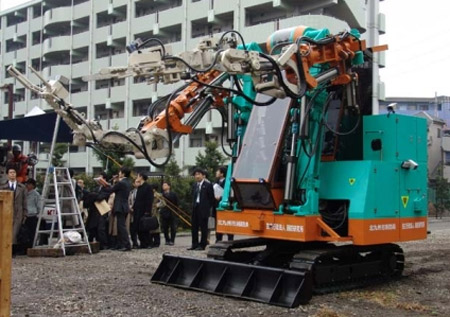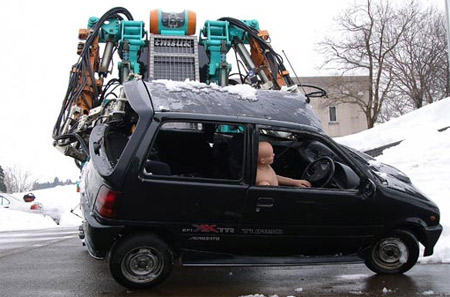T/ A new type of life-saving robot: PRE-HOSPITAL CARE ROBOT
This new prototype robot was developed specifically for the AICHI EXPO 2005 in collaboration with Kyushu University.
Visitors to the EXPO who felt ill, were able to utilize this robot to get medical assistance at the theme parks and public facilities that were hard to get to by ambulance. This experimental robot immediately relays information to hospitals and first-aid rooms as soon as someone sits it. Then it, automatically, takes readings of the vital signs like, taking the pulse, measuring blood pressure, heart beat rate and blood oxygen.In emergencies, doctors can administer first- aid by giving instructions directly to the robot or through a speaker and microphone system to bystanders.
We don’t have a decent photo of the pre-hospital care robot – but we do
have two of the T-52 Enryu Rescue Robot.
Our understanding of the state of robotics in use in the United States for emergency work is that they’re largely limited to EOD (explosive ordinance and demolition) work – as applied in the domestic context, evaluating, transporting, and disarming suspected explosive devices.
Via Toolmonger. Whom (who?) we thank not only for pointing this out to us, but for their superior journalism (superior to me , in any case) by being willing to point out that, function aside, these robots are, in their words, “just cool.” Which they are.
The non-pictured pre-hospital care robot transmits diagnostic data ahead to the hospital. Â
Here’s the limitation of this equipment: in the context of large, horrible, hard-to-solve incidents, they’ll save lives. And save the lives of first responders. But in mass incidents – and when circumstances make them hard to transport – their function is less limited.
I’m as prone to fall in love with shiny new technology as the next person. Or more so. But the policy question might be – given a choice between one million-dollar robot – or ten forward-cached containers of medical supplies – which would be the better first use of financial resources?
